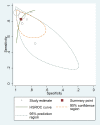Effect of Varying Definitions of Hypopnea on the Diagnosis and Clinical Outcomes of Sleep-Disordered Breathing: A Systematic Review and Meta-Analysis
- PMID: 31053203
- PMCID: PMC6510679
- DOI: 10.5664/jcsm.7750
Effect of Varying Definitions of Hypopnea on the Diagnosis and Clinical Outcomes of Sleep-Disordered Breathing: A Systematic Review and Meta-Analysis
Abstract
Study objectives: Various criteria have been used for scoring hypopneas, leading to difficulties when comparing results in clinical and research settings. We conducted a systematic review and meta-analysis to assess the effect of different hypopnea definitions on the diagnosis, severity, and clinical implications of sleep-disordered breathing (SDB).
Methods: Ovid MEDLINE, Embase, and Scopus databases were queried for English-language publications from inception through March 7, 2017. Studies that directly compared various hypopnea definitions were eligible. The hierarchical summary receiver operating characteristic model was used to jointly estimate diagnostic performance for comparisons between criteria.
Results: The initial search yielded 2,828 abstracts; 28 met inclusion criteria. After reviewing reference lists and expert review, five additional articles were identified. Most of the studies were cross-sectional or retrospective in nature. Eleven studies compared 2007 recommended criteria with 2012 criteria; 6 of these (evaluating 6,628 patients) were suitable for inclusion in the meta-analysis. Using the 2012 definition (≥ 3% desaturation or arousal) as the reference standard, the 2007 definition (≥ 4% desaturation) showed a sensitivity of 82.7% (95% confidence interval 0.72-0.90) and specificity of 93.2% (95% confidence interval 0.82-0.98). Although 2007 criteria were found to be associated with prevalent cardiovascular (CV) disease and increased risk of CV death, the 2012 criteria appeared to correspond better with intermediate CV risk markers based on two abstracts.
Conclusions: As expected, 2012 hypopnea scoring criteria resulted in a greater prevalence and severity of SDB. Data regarding the effect of varying hypopnea definitions on clinical outcomes, quality of life, health care costs, and mortality rates are limited.
Commentary: A commentary on this article appears in this issue on page 683.
Keywords: ROC curve; health care costs; hypopnea; prevalence; sensitivity and specificity; sleep apnea syndromes.
© 2019 American Academy of Sleep Medicine.
Figures
Comment in
-
Why a Single Index to Measure Sleep Apnea Is Not Enough.J Clin Sleep Med. 2019 May 15;15(5):683-684. doi: 10.5664/jcsm.7746. J Clin Sleep Med. 2019. PMID: 31053224 Free PMC article. No abstract available.
-
Effect of Varying Definitions of Hypopnea on the Calculation of the Apnea-Hypopnea Index May Depend Upon the Level of Sympathetic Activation: Results From a Patient With Posttraumatic Stress Disorder.J Clin Sleep Med. 2019 Oct 15;15(10):1555. doi: 10.5664/jcsm.8004. J Clin Sleep Med. 2019. PMID: 31596225 Free PMC article.
References
-
- Berry RB, Brooks R, Gamaldo CE, et al. for the American Academy of Sleep Medicine. The AASM Manual for the Scoring of Sleep and Associated Events: Rules, Terminology and Technical Specifications. Darien, IL: American Academy of Sleep Medicine; 2016. Version 2.3.
-
- Iber C, Ancoli-Israel S, Chesson AL, Jr, Quan SF for the American Academy of Sleep Medicine. The AASM Manual for the Scoring of Sleep and Associated Events: Rules, Terminology and Technical Specifications. 1st ed. Westchester, IL: American Academy of Sleep Medicine; 2007.
-
- Sleep-related breathing disorders in adults: recommendations for syndrome definition and measurement techniques in clinical research. The Report of an American Academy of Sleep Medicine Task Force. Sleep. 1999;22(5):667–689. - PubMed
-
- American Academy of Sleep M. International Classification of Sleep Disorders. Darien, IL: American Academy of Sleep Medicine; 2014.
Publication types
MeSH terms
LinkOut - more resources
Full Text Sources
Medical
Research Materials
Miscellaneous



